In this article I will be talking about how to possibly avoid pain (or at least cut down on it) in your drumming as well as some possibilities if you are already having pain. Weather you are young or older it’s always a good idea to be prepared and here are some preventative methodologies, strategies, ideas and techniques to preserve your body in healthy ways so you can enjoy your drums and drumming your whole life.

The first thing to realize is that if you don’t have pain, start to plan for avoiding it now. I am 59 and playing since I was a pre teen. We are all different and some things I talk about here may be useful and some may not be useful. Take what you need and leave the rest. I am not a medical doctor and you should consult your physician for medical advice. This is not meant as medical advice.
The first thing to look at is your playing technique. You might sound fantastic and love your technique. You may have been playing a really long time. However, if you are in pain you may also need to re-learn how to hit the drum differently in order to not have pain or create pain later on. Most of us, especially when we really get into it, get into the zone are not thinking about how hard we are hitting the drum. We all get stuck in patterns. These patterns become natural and comfortable, but we may need to break them.
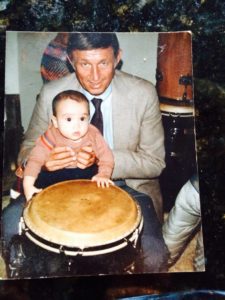
Many times when we are playing, we are just feeling, creating or having fun. Or maybe we are performing, playing with friends or holding down a part. But whenever we play, most people are not thinking about how loud they are playing or how hard they are hitting the drum.
Most of us play too loud and too hard. Sometimes it’s simply survival, to hear our selves in a crowded situation. And many times it is because our technique is not bringing out the sound of the drum.
If we train or play constantly in situations where it is very high volume (such as drum circles) and later you play in smaller situations, or musical situations you need to remember you do not have to play at full volume.
You can save energy, have more fun and be a much more musical person if you check out your sound level constantly and keep it in check as well.
If you play a conga drum there are so many wonderful and different styles to play drums where you don’t need to kill the drum. You can learn these techniques from a qualified teacher and sometimes even on line if you are lucky. And the skin can make a huge difference. Try a thinner skin.
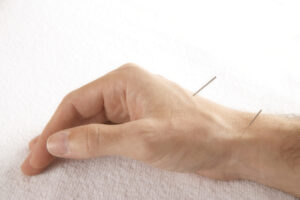
The same goes for djembe. If you are concerned about joint pain or injury I highly recommend you explore different playing techniques for how you hit the drum and get sound to come out.
Please remember, there is no “one right way” or one wrong way to hit the drum. It is whatever works best for you. Make sure your technique how you make all your sounds feels good on and in your body.
Posture comes in to play even when we are talking about the hands. “The hip bones-connected to the rib bone”, song and theory. Everything is connected. Your playing position including how straight your back is is very important. You don’t want to be slumped over. Your head is very heavy, like a bowling ball. It can pull on your shoulder muscles, neck and upper back if you are staring down at your hands all the time. When playing imagine there is a soft ball between your inner elbow and your ribs. This gives you the proper set up to achieve a powerful stroke for hitting the drum.
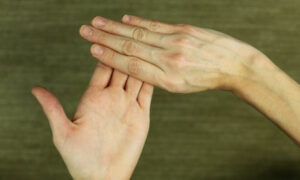
If you are sitting too low or too high, if your arms are dropped and where and how you make contact with the drums, from what angle…all play an important part of the equation in making sound easily and efficiently and also if you have any pain any where win your body.
In my experience teaching I have found that even the slightest adjustment can make a big difference in having writ or arm pain for example.
Playing in front of a mirror is a great way to “self correct”. You can see if your head is hanging, if your shoulders are up on one side and down on the other and many other useful tid bits. Study your playing style. It has helped me immensely.
Smiling relaxes our face, jaw and neck. Not only does smiling help us relax, it reminds us playing is fun and to not be so serious. Please remember to smile whenever you can.
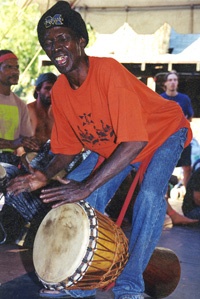
Skin thickness can cause or help with pain reduction. On djembe you may want to avoid cow skins or super thick skins pulled to the tightests possible position. The thickness and hardness of cow or super thick goat cranked to the high heavens can really reack havoc on your hands and joints.
It’s something to think about. Did you know that 15 -20 years ago the drums were never pulled as high as they are today? Take a look at what the older master drummers are playing on their drums. It’s almost always goat.
With the advent of the “fast, faster and fastest” competitive ballet styles, showmanship on Youtube and the popularity of drumming “gymnastics”, the djembes have become cranked up super high. The reason is it is easier to play faster and louder on a drum that has a tight hard skin. You can indeed do rolls faster.
You may want to look at the style of drumming you do as well and if you a re on djembe I suggest looking and listening to the Mali village styles of drumming as an example of alternative ways to play where you possibly do not play at full speed as hard as you can all the time.
Precautionary measures for skin care can include rubbing in shea butter or other salves but is is advised to put it on 45 minutes prior to playing so that it really works into your hands and not the drum skin. Oild can and will damage your skin.
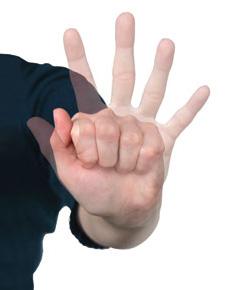
I also recommend yoga and/or stretching exercises particular those targeted at neck, shoulder, arms, wrists and fingers. I have several free video of these on Youtube. You can modify the exercise as need be to fit your needs but stretching prior to playing and after playing is a must.
If I am playing in a dance class and there is a break I will indeed do some stretching exercises in between. If you have a rest stop work in stretches!
If you can get massaged regularly or you can massage your self as well. You can press the pressure points of your wrists and also do acu-preassure up and down your own arms. It is quite easy and simple to learn how to do it. I have a thin rock I use to push into my muscles for example.
Many people believe that your diet is very important. What you include, exclude, need or don’t need can play a role in over all health and in joint or other pain issues in the body. You are on your own to explore this as nutrition is a huge subject unto and on itself. Let me know what you find out! Of course there are various supplements to explore. Acupuncture, herbs and even herbal compresses (such as ginger compresses) can be incredibly helpful and powerful tools.

When you already have pain many “old heads” put shea btter on their hands and soak their hands in very hot water with epsom salts. This works especially well for me after performances. Again you have to find what works for you.
Please remember to breathe when you play. As simplistic as this sounds i have noticed many people hold their breath or breathe abruptly when playing. You must relax when you play drums. If you are tense, you hit the drums tense it’s too much “tense”. It’s then 2 hard things hitting each other.
I am suggesting finding a way, a style and technique where you are maximizing your output with minimum input. I call this “effortless drumming”. You are still putting in your full energy your ae just not striving and tensing like a knot.

The key to “effortless drumming” is to remain calm and centered with out stiffness and contraction. If you practice playing at different speeds at home instead of a slow comfortable speed you can train your body to remain relaxed under most conditions. Make sure to challenge yourself when you practice.
When rhythms speed up, (which they almost always do), our natural inclination is to play louder and tense up which sometimes can stop the rhythm from flowing.
However, if we tell or remind ourselves to breathe, play slightly lower in volume and relax when rhythms speed up the opposite effect happens…the rhythm can really take off. Try it next time.
Therefore, must remain or become flexible. The power in drumming comes not from how hard we hit the drum, but from the accuracy of the technique we use. This is called technique. The methodology which we use to extract the sound from the drum.
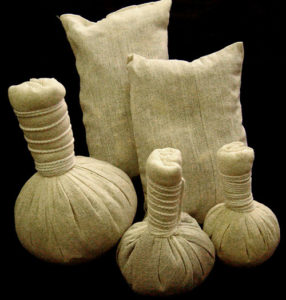
How we hit the drum is so important. Instead of “attacking” the drum think about making great music. Set your mind right, breath and relax when you play . You will have more fun and it is healthier for your body as well.
I suggest not playing when you are angry and focusing on positive energy if that appeals to you. When we play while were are angry or upset we can hurt ourselves.
And remember, the mirror I mentioned is your best friend. It can show you and teach you many things about your playing, how you are holding your body, how you are hitting the drum.
You can watch a video of hand technique or simply watch great players on youtube then watch your own technique. See where you differ or are similar. I like to go back and fourth and find this very helpful. I also like to practice arm movements in the air not hitting the drum.

On the djembe I always ask people to imagine they are pulling the sound out of the drum and their hands are floating up and out in to the air after they hit.
You hit the drum like you are bouncing a basketball. Your hand is not limp, it’s strong and flexible. Your hands are like a diving board that is strong yet flexible it bends and yields but it does not break.
What is the situation where you play? What are the circumstances of how you express yourself on the drum?
What I am saying is this. You may need to change the circumstances of where you play, what style of music you play , how you play and even who you play with to rid yourself or heal pain. The pain is simply a messenger that something is wrong or your body is not liking how you are doing it. So we need to listen to this and look to all the positive ways we can heal.
We all need to find the right style of music to play and the right instrument. If you have pain, instead of quitting, you may want to explore the various possibilities of playing other percussion instruments you may not have considered before. You may need to change the style of music you play as well.
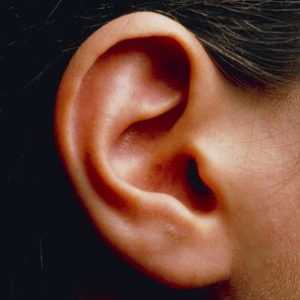
While we are at it, don’t forget ear protection and save your ears and hearing from nerve damage. You can use foam ear plugs and there are a huge variety of professional audio hearing protection devices as well that let partial sound in.
As I mentioned prior there are several holistic health modalities that have proven them selves to be quite useful.
You have nothing to loose trying them. Acupuncture, chiropractic and herbal remedies have helped many people. I have used hot ginger compresses and other macrobiotic remedies quite effectively as well.
Remember to pace yourself when you are drumming. You will have just as much fun. As we age a great strategy is to conserve your energy and think about how you are going to play, what you will play and how you will play it. Take rest stops if you need it. Drop the ego and take care of yourself. Much needless energy is often spent playing to hard at the wrong times for too long. Save energy for the end of your event be it a dance class, drum circle or performance.

When we were younger we could mistreat your body, we could do all kinds of things we simply can’t do as we age. It’s simply the reality of everyone’s situation. Our playing styles must also change.
Personally, I like to study “phraseology”, using phrases, crossing time and space as a way to solo, rather then filling my solos with busy notes back to back.
Space is your best friend when soloing. By using space and phrasing we can solo in very interesting ways that don’t have to be about playing as hard and fast as we can.
When we are playing next to someone who is playing a solo very fast with many notes and also very loud it is very tempting and easy to get pulled into playing this style when it is our turn to play. It could be at a rumba or drum circle, or maybe a dance class. Or maybe you are soloing in a band. The temptation is always there to jam and cram notes together and focus on rolls or too many notes.
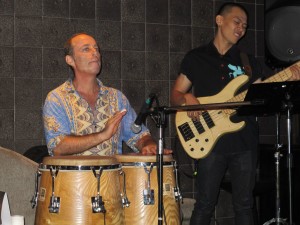
However, if we have a plan or strategy to use phrases, solo chains and space we can avoid this competitive style, have more fun and also make a strong creative statement that is both musical and powerful in it’s on right.
I suggest planning ahead of time how you will act and respond and the themes you might visit or use.
If you are in pain or want to avoid pain please think or rethink your playing strategies and styles and see if incorporating any of the ideas we have discussed in this article work for you. Please remember to always warm up before you play or perform. Incorporate gentle or vigorous stretching into your routine depending on what works for you. If you ar win pain please check out some alternative healing modalities if this interests you.
If you have pain I strongly recommend you see your doctor or qualified health practitoner. Many people suggest and use physical therapy as well. However, if you don’t correct the situation that got you there in the first place, the pain is just going to come back again.

